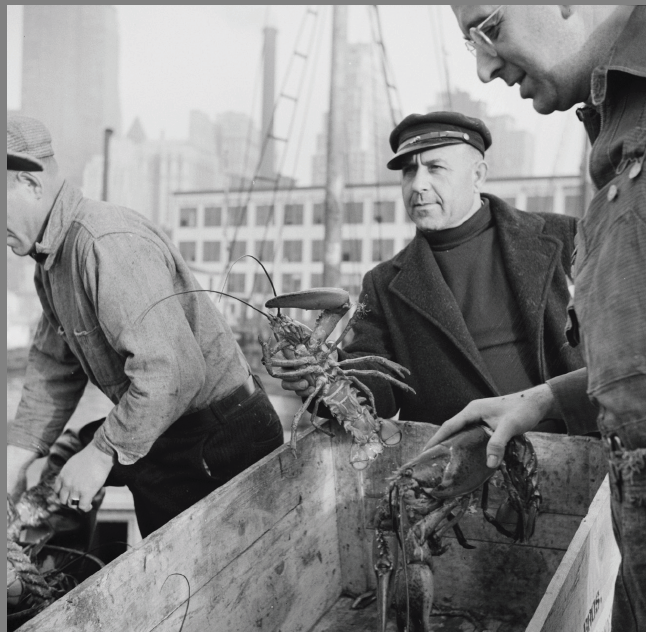A lobster from southern New England is offered for sale at the Fulton Fish Market in New York City in 1943. Source: Library of Congress archives

Twenty years ago, Long Island Sound was home to a thriving fishery of the American lobster. Hundreds of lobster boats brought in 3.7 million pounds
worth more than $12 million to the Connecticut side, and almost double that catch arrived in New York ports. In a half-century, Connecticut-landed lobsters had increased twelvefold (from 226,300 pounds in 1950). It was a tiny economy next to the much larger Maine lobster fishery, but it represented the top of a boom for the Sound and a livelihood for hundreds of fishers.
And then, in 1999, something went terribly wrong. More than half of lobsters commercial fishers pulled up were dead in the traps or died before they could get to market. In the years since, 99 percent of the lobstermen in the once lobster-abundant waters of the western Sound have gone out of business. What caused this? Scientists have spent the years since then gathering data with the help of lobster trappers and
coming up with an answer.
Three potential causes have been identified and studied, but the evidence points strongly to one factor in particular. It’s temperature. The Sound today is too warm too often for this cold adapted species. Despite some years of slight increases in their numbers, Long Island Sound lobsters have failed to recover from the 1999 die-off, when the warm conditions persisted for more than 60 days.
There is no better public example of climate change in Long Island Sound than the lobster. Its demise connects directly to warmer temperatures. Perhaps the most poignant detail in this tragedy is that these lobsters eventually die out in situ, wired by instinct not to relocate. They are not migratory animals. The remnant population remains here. Every instinct tells these lobsters not to move.
What happened
Scientists from the Connecticut Department of Energy and Environmental Protection, the University of Connecticut and other institutions have tracked three stressors that hit the ecosystem at once in that dramatic year of 1999.
First came pesticides. West Nile virus, a bird-carried pathogen from Africa whose presence was confirmed for the first time that year in birds and mosquitoes in the New York-Connecticut region, was the spark. The potentially fatal virus soon would spread to horses and people, and in response to what
seemed a potentially dangerous threat, several cities and towns began floating solid cakes of the chemical methoprene in storm drains. New York and Connecticut officials also sprayed other mosquito-killing chemicals from airplanes.
Although some of the pesticides do hurt lobsters in laboratories, several studies failed to find a link between pesticide use and the lobsters’ demise, according to Penny Howell, a retired DEEP fisheries biologist who spent the last part of her career studying what happened to the lobsters. The worst of the pesticides used to kill mosquitoes, malathion, could have hurt lobsters in the extreme western Sound, scientists from DEEP, Connecticut and New York Sea Grant and the University of Connecticut found.
“We really thought that was just too minimal to be a real cause,” Howell said. “It was not a wide enough an area and long enough in duration to really be the principal cause.” Hypoxia, or low levels of dissolved oxygen in the water, does not kill lobsters either unless the levels are very low, 2 milligrams per liter of dissolved oxygen, she said.
Diseases were a second major stressor. Epizootic shell disease, an infection causing lesions, hit lobsters badly in eastern Long Island Sound in 1999. They looked mottled and weak when pulled out of the water. This was the focus of a study published this fall in the American Naturalist by scientists from Millstone Nuclear Power Station in Waterford and the Virginia Institute of Marine Science at the College of William and Mary. It looked at market data over 34 years and concluded that warmer water causes lobsters to molt quickly in the spring, making them more vulnerable to shell disease. First warmth, then comes vulnerability to shell disease. These conditions may also have accelerated the growth of a strain of parasitic amoeba that actually killed many of the lobsters that year. More than 90 percent of lobsters examined that year were infected.
This leads to the last and most significant stressor that killed lobsters in 1999. For about two months that year, the Sound warmed to temperatures higher than lobsters can tolerate.At the high point, the temperature measured nearly 72 degrees F (about 22 degrees C), about 3 degrees warmer than the hottest temperature Homarus americanus can stand. The previous winter was also warmer than normal. Warmer water in the Sound has become the norm. The American Naturalist study noted what many scientists now agree is the reality: The American lobster “is declining at its southern geographic limit.”
The temperature in the Sound is increasing at about 0.8o F (about 0.47o C) per decade, that study reported. James O’Donnell, professor of marine sciences at UConn, reported that the warming over the last 100 years is about 1.8 degrees F (about 1 degree C).
“This trend is resulting in profound impacts on biological communities such as fish and shellfish,” the University of Connecticut and Connecticut Department of Energy and Environmental Protection reported in their joint Long Island Sound Resource Center climate change monitoring report. This trend is having profound impacts on biological communities such as fish and shellfish.
Since the 1990s, lobster landings from Long Island Sound have decreased sharply. Basically, just a remnant commercial fishery still exists. Howell now gives public talks summarizing the surveys and studies she coordinated on the lobster demise. The 1990s were “a big boom,” she said. “The lobster really is a cold-water animal that can’t tolerate [warm water].”
Landings of lobsters for sale in markets hovered around 2 million to 3 million in Connecticut in the 1980s and 1990s. Since then, the numbers of lobsters landed have dropped so significantly that they don’t show on the state’s graphs of lobster landings over time. This crash cannot be blamed on the lobster trappers. It’s not the fishery’s fault, Howell said.
A short economic history
The commercial lobster industry in the Connecticut waters of Long Island Sound peaked and then began to decline over a relatively short period. Although lobsters have served as food ever since civilizations here devised ways to trap them, selling them on a large scale grew only after World War II. The number pulled out of the Sound for sale grew steadily from 1950, peaked 48 years later, and by 2016 had dipped back to about the 1950 number. Even as they begin what could be a final decline, lobsters remain a valuable delicacy.
New York landings from the Sound trend higher in more recent years, possibly because the figures are estimates, but for the most part the New York landings match Connecticut’s.
The rate of harvesting was “pretty high when the population went high,” Howell said. “We saw a brief increase in abundance which the fishery took advantage of in 2005. It’s no great demise in harvest rate through 2013, but it’s hard to say that overharvesting caused the problem, because we should have seen some kind of an increase in 2002, 2003 and 2004, and we didn’t. It’s getting the fishery off the hook. It’s not their fault.”
The heat
Lobsters become sluggish in warmer water. One 2006 study found that lobsters in too-warm waters become sick. The animals can adjust to a warmer average temperature, but the result then is that they suffer heart problems during cold spells, the study concluded. They become less resilient.
Beyond the Sound and north of Cape Cod, lobsters are doing well. In Maine the population seems to be enjoying an incredible boom. But that boom is feared to end at some point. Scientists are watching the water temperature trends in the Gulf of Maine and Georges Bank. More and more researchers and resource managers are starting to investigate the effects of environmental changes on American lobsters in northern New England waters.
Could lobsters from the Sound simply crawl their way to colder waters? Probably not. Lobsters are not migratory animals. Studies have shown consistently that the lobsters in the Sound tend not to move much.
But they would move if they could find a food source in colder water, Howell explained. The trouble is the way the Sound is set up. With cooler water coming in from the East River at the western end and the Atlantic Ocean at the eastern end, a whole lot of warmer water gets sandwiched in the center, and the lobsters don’t realize there’s anywhere else to go.
When the Sound warms up, she said, it warms up in the middle first and then at both ends, because cold water comes in from either end. Those lobsters on the mud bottom of the western Sound can’t get out to the open ocean unless they migrate east through the warmer central Sound and toward the Race, the narrow opening to the Atlantic Ocean at the eastern end. But lobsters will never go toward warm water if given a choice.
“What we realized was that when the Sound warms up, it warms up from the middle and then the edges,” she said. “That means that these animals here would have to go from warm water to warmer water and we do have published laboratory behaviorial experiments that show that if you put a lobster in a setup where
the animals choose between very small changes of temperature, two streams of water coming at it, it will always go to colder water. It will never
go to warmer water.”
She added, “They would have to be very good navigators in order to get out. They only will go if there’s no food. And they only will go if there’s a way for them to get out.”
